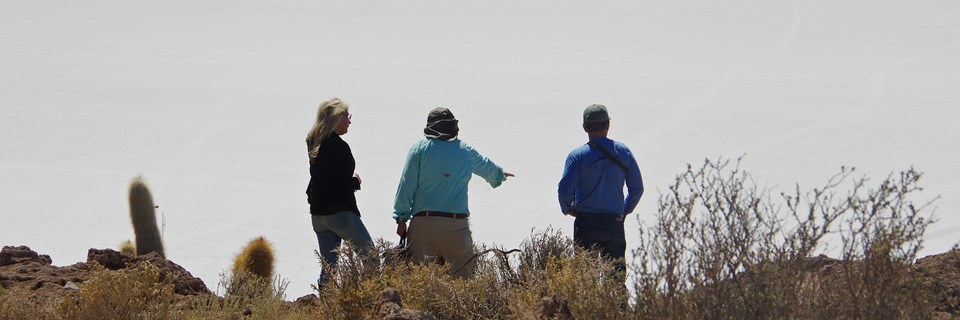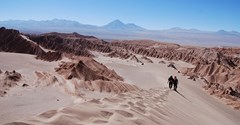Read about our travels across Bolivia's Salar de Uyuni, where ancient Incas and British-built locomotives once trod.
Having got to know the curious customs of Copacabana, on the shores of Lake Titicaca and having rode the world's highest cable car over the streets of La Paz, Veloso Tours team member Chris shares his experiences as he enters the world's biggest and highest salt flats in Uyuni.
Endless Horizons
It was somewhat jarring to look out of the windows of our Toyota Landcruiser and gaze towards seemingly endless horizons. We'd spent several days travelling along rural Andean roads, first in Peru and then in Bolivia, often enclosed by rolling mountains and lined with verdant trees, remote settlements and patch-work fields in which cows grazed and farmers tended their crops. Now there was little disturb the views beyond periodic signs warning of the tendency for llamas or guancacos to wander across the road and the occasional sighting of the animals in question, fortunately for their sake a safe distance from our vehicle. After snapping up some of the local souvenirs (made predominantly from salt, naturally) and the obligatory bright orange Godzilla toy (more of which later) from the small town of Colchani, it is onwards into the great white expanse.
I'll admit that on first impressions, this great white expanse seemed a bit... yellow. I momentarily lifted my sunglasses (mandatory at this altitude) to verify that ahead of me lay a seemingly infinite mass of salt that looked like the punishing sun had baked it to a salty golden crisp. Had every photo of the salt flats that I've ever seen had some devious Photoshop treatment then? Alas, no they hadn't. As we pushed deeper into the heart of what was once a mind-bogglingly vast pre-historic lake, the ground desaturated to a brilliant white, which popped markedly against the vivid primary colours of a wind-beaten collection of national flags from around the world, stationed outside the eerily empty original salt hotel.
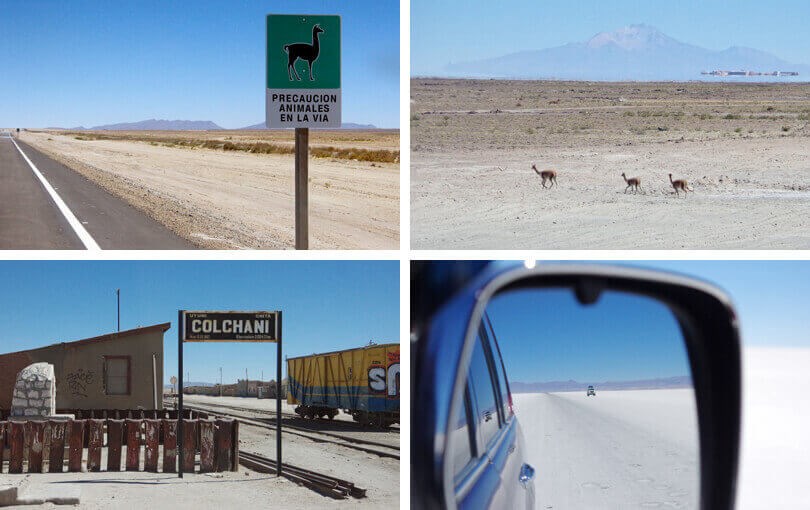 Scenes from the road to the Salar
Scenes from the road to the Salar
In the footsteps of the Incas
Our driver Leo thundered away over the salt, following the dark tracks that lay ahead. These are the closest things to roads here, created each dry season by the powerful tread of 4x4s as they plough their course forward, often appearing to veer in one direction, before sweeping gently to the other and creating subtle curves. Our first proper stop is at the Isla de los Pescadores, the most famous internal point of reference in the salt flats. Covered in towering cacti and minute ancient coral, this huge outcrop holds historic significance, as well as affording perhaps the best views of the sea of salt.
A clue to its past is found in the island's Quechua name; Incahausi, or 'house of the Incas'. It was to here that Incas sought refuge during long treks across the sparse landscapes and to escape the clutches of the 16th century Spanish Conquistadors, whose horses were ill-equipped to survive the punishing pursuit. The same can't be said for the hardy group of cyclists who joined us (and some alpacas) as we stopped for lunch, having heaved our way up to the lookout point on the island's summit.
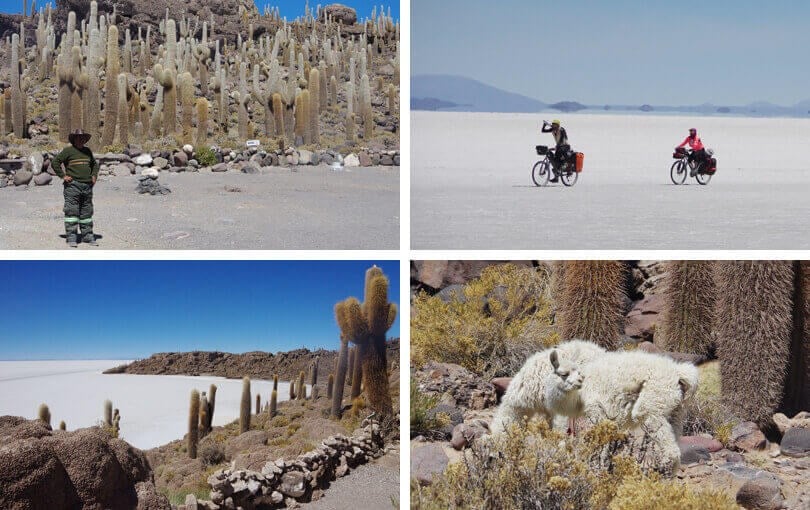 Scenes from Isla de los Pescadores
Scenes from Isla de los Pescadores
The Salar de Uyuni spreads out over 4,200 square miles in total, a land mass bigger than nine US states and all but one English county. Such scale is both easy to appreciate when surveying the the hexagonal patterns repeating themselves endlessly towards the horizon and somewhat more difficult when a lack of reference points shrinks perspectives in mind-boggling ways. As we headed towards Coquesa, a tiny settlement at the foot of Volcan Tunupu, our local expert Arturo pointed out the looming volcano ahead and asked us to guess how many miles lay ahead of us. With nothing but salt between us and our destination, it seemed like a short hop across of perhaps 4 or 5 miles. Apparently not. To my immense surprise the answer was closer to 20 miles.
Before that though, it was time to pull over and unleash Godzilla.
The Godzilla Moment
One of the many things that makes Uyuni so special is the feeling of utter liberation one gets from seeing the salt stretch far off into the distance, disturbed only by distant blue mountains. There are various points when the horizon in fact remains completely clear, where salt and sky converge as one. It is in these spots that groups of visitors display their creative genius in mind-bending arrangements, uploaded for prosperity to social media at the first sign of a WIFI connection. This is where our orange friend comes in.
We leave it in the hands of Arturo to setup the shot, sending us marching off into the distance until we shrink sufficiently that Godzilla looms menacingly over us. We turn to face our bodies side-on, thrust our hands in front of our face and do our best panic-stricken faces towards a non-existent monster. As we reconvene with Arturo, clearly delighted with his efforts, I haven't the heart to tell him that the big orange creature is a bit out of focus and ask a grown man to put his plastic toy on the ground, take several steps back and get on his belly for a better angle. We all laugh at the result and I wonder what exactly we are going to do with the toy now that it has fulfilled its life work - I'm not sure my three year old niece is ready for such a scary monster yet.
A bed of salt
Andean flamingos and a large pack of fluffy llamas await us at Coquesa, a small group of red-roofed stone buildings, overlooked by the jagged multi-coloured Tunupa Volcano. In one of said buildings is a tiny museum which displays tools and artefacts of traditional life, though the collection of weird and wonderfully carved stones outside is of equal interest, not least the curious presence of sheep skulls carefully placed on neck-shaped pieces of rock. It's a little disconcerting at first glance, but nothing compared to the human remains of an Inca we were introduced to, cooped in a tiny cave. Fortunately we had a lot more space to spread out in our hotel. My earlier exertion bounding up the Isla de los Pescadores were beginning to take a toll and after ten days at high altitude I was beginning to feel the first effects of the dreaded soroche.
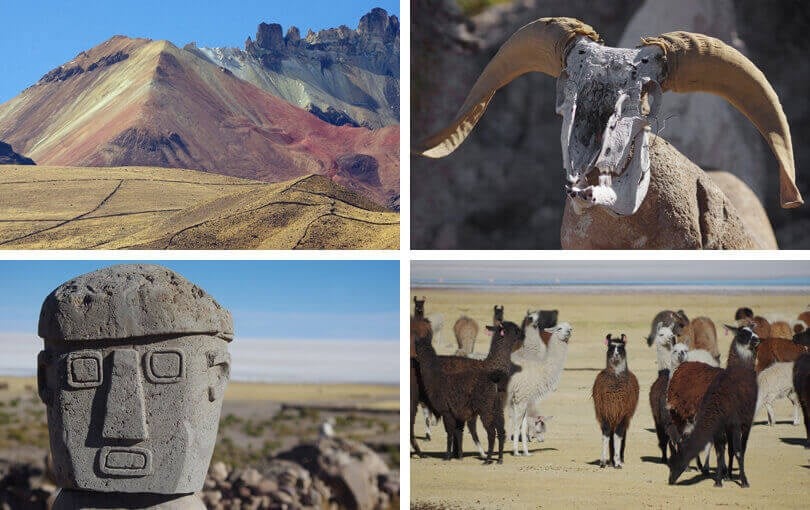 Coquesa & Volcan Tunupa
Coquesa & Volcan Tunupa
Of course it isn't enough to just visit the salt flats for the day, for the full experience you have to lay down your head on a bed made of salt, in a hotel made of salt. Immersive hotels are nothing new of course, the Ice Hotel of Jukkasjärvi is Sweden and the fairy chimneys of Cappadocia in Turkey stand as equally unusual abodes, fashioned into and out of the surrounding landscape. But for these hotels to survive and thrive they have to go beyond being a mere gimmick, because the novelty factor soon wears off if the service isn't up to scratch, or if you wake up in the middle of night with a cold drip of melting ice water on your head. Thankfully the Hotel Luna Salada lives up to expectations, not least the thick mattresses that provide a welcome layer of comfort between you and the salt and the inviting hammocks that hang lazily in small lounge areas outside most rooms, bathed in soft evening light and accompanied by roaring log fires. The following morning I made the mistake of collapsing into one of those hammocks, something I regretted after the pathetically almighty effort it took to haul myself back out. I was going to take it easier today as we began our two day drive towards the Chilean border.
When the wheels stopped turning
Our epic journey south began with a very short one, as Leo steered the Landcruiser to the rusting collection of locomotives at the Uyuni Train Cemetery. The catastrophic loss of Bolivia's coastline to Chile in the late nineteenth century Pacific War was to be offset by a complex train system to ferry the precious minerals extracted from the Andean interior to the now Chilean coastal ports. Sadly though the project was beset by a myriad of problems and even obstructions from the local indigenous communities, who deemed it to pose an unacceptable threat to their way of life. The final nail of the coffin came with the collapse of the Bolivian mining industry in the forties, rendering it completely redundant. Almost overnight the trains were stopped in their tracks and were left at the mercy of the elements. Today, the oxidized trains stand as a poignant monument, battered over time by the harsh winds.
 Uyuni Train Cemetery
Uyuni Train Cemetery
It's time to leave Uyuni behind and head from the world's biggest salt flats to the cinematic rock formations, towering geysers and mesmerizing night skies of the world's driest non-polar desert; the Atacama in Chile. On the way we would pass some of most beautiful landscapes I've ever had the privilege of witnessing, often in complete isolation and far from any civilization. It's a journey that relatively few visitors to Uyuni make, preferring instead to fly off elsewhere or take the express road down to San Pedro de Atacama. If you're ever faced with such an opportunity though, I urge you to take it. As we say in our brochure "the altitude is tiring, the nights freezing and the mountain track bumpy." But it's all part of the unique Bolivian adventure, which starts in the great white expanse.
Part II: Driving through a landscape photographer's dream in Bolivia
Choose your perfect holiday
Find inspiration from our selection of itinerary suggestions, a great starting point for your next trip
View More Tours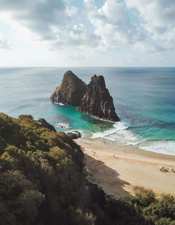
Stay in touch
Infuse your travels, with inspiration from our monthly newsletter.
READY - 20 April 2024
LANDMARK TOURS: Multi-Country & Cross Continent. New Cosmopolitan Tour: Buenos Aires, Iguazu, Rio
CHINA & INDIA: Local Life, People & Unique Cultures
GUIDES by Veloso Tours, are the best Local Hosts
PRIVATE VILLAS: Quality Time in exclusive settings
TRAVEL INSURANCE with extensive COVID-19 cover
